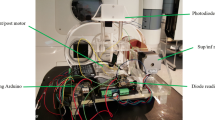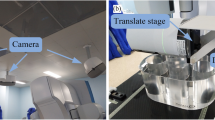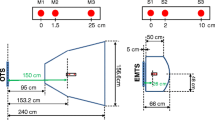Abstract
Recent developments in radiotherapy have focused on the management of patient motion during treatment. Studies have shown that significant gains in treatment quality can be made by ‘gating’ certain treatments, simultaneously keeping target coverage, and increasing separation to nearby organs at risk (OAR). Motion phantoms can be used to simulate patient breathing motion and provide the means to perform quality control (QC) and quality assurance (QA) of gating functionality as well as to assess the dosimetric impact of motion on individual patient treatments. The aim of this study was to design and build a motion phantom that accurately reproduces the breathing motion of patients to enable end-to-end gating system quality control of various gating systems as well as patient specific quality assurance. A motion phantom based on a stepper motor driver circuit was designed. The phantom can be programmed with both real patient data from an external gating system and with custom signals. The phantom was programmed and evaluated with patient data and with a square wave signal to be tracked with a Sentinel™ (C-Rad, Uppsala, Sweden) motion monitoring system. Results were compared to the original curves with respect to amplitude and phase. The comparison of patient curve data showed a mean error value of −0.09 mm with a standard deviation of 0.24 mm and a mean absolute error of 0.29 mm. The square wave signals could be reproduced with a mean error value of −0.03 mm, a standard deviation of 0.04 mm and a mean absolute error of 0.13 mm. Breathing curve data acquired from an optical scanning system can be reproduced accurately with the help of the in-house built motion phantom. The phantom can also be programmed to follow user designed curve data. This offers the potential for QC of gating systems and various dosimetric quality control applications.
Graphical Abstract









Similar content being viewed by others
References
Freislederer P, Reiner M, Hoischen W et al (2015) Characteristics of gated treatment using an optical surface imaging and gating system on an Elekta linac. Radiat Oncol 10(1):68. doi:10.1186/s13014-015-0376-x
Kissick M, Mackie W, Rockwell T (2009) Task group 76 report on ‘the management of respiratory motion in radiation oncology’ [Med. Phys. 33, 3874–3900 (2006)]. Med Phys 36(12):5721. doi:10.1118/1.3260838
Giraud P, Houle A (2013) Respiratory gating for radiotherapy: main technical aspects and clinical benefits. Int Sch Res Not Pulmonol. doi:10.1155/2013/519602
Korreman S, Juhler-Nøttrup T, Fredberg Persson G et al (2008) The role of image guidance in respiratory gated radiotherapy. Acta Oncol 47(7):1390–1396. doi:10.1080/02841860802282786
Schlegel W, Bortfeld T, Grosu A (2005) New technologies in radiation oncology. Springer, Berlin
Klein E (2010) TU-B-203-01: QA of radiation delivery systems: TG-142 quality assurance of medical accelerators. Med Phys 37(6):3373–3374. doi:10.1118/1.3469182
Gaya A., Mahadevan A (2015) Stereotactic body radiotherapy. Springer, Berlin
Pawlicki T, Mundt AJ (2011) Quality and safety in radiotherapy. CRC Press, Boca Raton
Guckenberger M, Richter A, Boda-Heggemann J et al (2012) Motion compensation in radiotherapy. Crit Rev Biomed Eng 40(3):187–197. doi:10.1615/v40.i3.30
Marcu L, Bezak E, Allen BJ (2012) Biomedical physics in radiotherapy for cancer. CSIRO, Collingwood
Cetnar AJ, James J, Wang B (2016) Commissioning of a motion system to investigate dosimetric consequences due to variability of respiratory waveforms. J Appl Clin Med Phys 17(1)
Cheung Y, Sawant A (2014) SU-C-BRF-05: design and geometric validation of an externally and internally deformable, programmable lung motion phantom. Med Phys 41(6):98–98. doi:10.1118/1.4889725
Grohmann C, Frenzel T, Werner R et al (2015) Design, performance characteristics and application examples of a new 4D motion platform. Zeitschrift Für Medizinische Physik 25(2):156–167. doi:10.1016/j.zemedi.2014.09.003
Dunn L, Kron T, Johnston PN et al (2011) A programmable motion phantom for quality assurance of motion management in radiotherapy. Australas Phys Eng Sci Med 35(1):93–100. doi:10.1007/s13246-011-0114
Tang X, Saleh Z, Volpe T, Margiasso R, Lovelock D, Li X, Chan M, Hunt M, Deasy J (2015) SU-E-J-63: initial validation of the surface beacon transponder. Med Phys 42(6):3278–3278
Sibolt P, Ottosson W, Sjöström D, Larsen C, Behrens C (2015) Adaptation requirements due to anatomical changes in free-breathing and deep-inspiration breath-hold for standard and dose-escalated radiotherapy of lung cancer patients. Acta Oncol 54(9):1453–1460
Jönsson M, Ceberg S, Nordström F, Thornberg C, Bäck SÅJ (2015) Technical evaluation of a laser-based optical surface scanning system for prospective and retrospective breathing adapted computed tomography. Acta Oncol 54(2):261–265
L297 Stepper motor controllers datasheet. STMicroelectronics
Lempart M, Kuegele M, Ambolt L, Blad B, Nordström F (2016) Latency characterization of gated radiotherapy treatment beams using a PIN diode circuit. Innov Res Biomed Eng 37(3):144–151
Acknowledgements
The study was approved by the Regional Ethics Board of Lund, Sweden (EPN Lund, Dnr 2013/742).
Author information
Authors and Affiliations
Corresponding author
Ethics declarations
Conflict of interest
The authors declare that they have no competing interests.
Ethical approval
The study was approved by the Regional Ethics Board of Lund, Sweden (EPN Lund, Dnr 2013/742).
Rights and permissions
About this article
Cite this article
Lempart, M., Kügele, M., Snäll, J. et al. Development of a novel radiotherapy motion phantom using a stepper motor driver circuit and evaluation using optical surface scanning. Australas Phys Eng Sci Med 40, 717–727 (2017). https://doi.org/10.1007/s13246-017-0556-0
Received:
Accepted:
Published:
Issue Date:
DOI: https://doi.org/10.1007/s13246-017-0556-0




